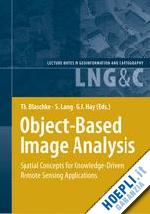Why object-based image analysis.- Object-based image analysis for remote sensing applications: modeling reality – dealing with complexity.- Progressing from object-based to object-oriented image analysis.- An object-based cellular automata model to mitigate scale dependency.- Geographic Object-Based Image Analysis (GEOBIA): A new name for a new discipline.- Image objects and geographic objects.- Multiscale representation and object-based classification.- Using texture to tackle the problem of scale in land-cover classification.- Domain-specific class modelling for one-level representation of single trees.- Object recognition and image segmentation: the Feature Analyst® approach.- A procedure for automatic object-based classification.- Change detection using object features.- Identifying benefits of pre-processing large area QuickBird imagery for object-based image analysis.- A hybrid texture-based and region-based multi-scale image segmentation algorithm.- Semi-automated forest stand delineation using wavelet based segmentation of very high resolution optical imagery.- Quality assessment of segmentation results devoted to object-based classification.- Automated classification, mapping and updating: forest.- Object-based classification of QuickBird data using ancillary information for the detection of forest types and NATURA 2000 habitats.- Estimation of optimal image object size for the segmentation of forest stands with multispectral IKONOS imagery.- An object based approach for the implementation of forest legislation in Greece using very high resolution satellite data.- Object based classification of SAR data for the delineation of forest cover maps and the detection of deforestation – A viable procedure and its application in GSE Forest Monitoring.- Pixels toobjects to information: Spatial context to aid in forest characterization with remote sensing.- Automated classification, mapping and updating: environmental resource management and agriculture.- Object oriented oil spill contamination mapping in West Siberia with Quickbird data.- An object-oriented image analysis approach for the identification of geologic lineaments in a sedimentary geotectonic environment.- Classification of linear environmental impacts and habitat fragmentation by object oriented analysis of aerial photographs in Corrubedo National Park (NW Iberian Peninsula).- Multi-scale functional mapping of tidal marsh vegetation using object-based image analysis.- A Local Fourier Transform approach for vine plot extraction from aerial images.- Automated classification, mapping and updating: land use / land cover.- Object-based classification of IKONOS data for vegetation mapping in Central Japan.- Structural biodiversity monitoring in savanna ecosystems: Integrating LiDAR and high resolution imagery through object-based image analysis.- Fusion of multispectral optical and SAR images towards operational land cover mapping in Central Europe.- The development of integrated object-based analysis of EO data within UK national land cover products.- Automated classification, mapping and updating: urban applications.- Detecting informal settlements from QuickBird data in Rio de Janeiro using an object based approach.- Opportunities and limitations of object based image analysis for detecting urban impervious and vegetated surfaces using true-colour aerial photography.- Object-based Image Analysis using QuickBird satellite images and GIS data, case study Belo Horizonte (Brazil).- An object-based approach to detect road features for informal settlements near Sao Paulo,Brazil.- Development of new methodologies.- Object-oriented analysis of image and LiDAR data and its potential for a dasymetric mapping application.- Characterising mountain forest structure using landscape metrics on LiDAR-based canopy surface models.- Object detection in airborne laser scanning data - an integrative approach on object-based image and point cloud analysis.- Support Vector Machine Classification for Object-Based Image Analysis.- Genetic adaptation of segmentation parameters.- Principles of full autonomy in image interpretation. The basic architectural design for a sequential process with image objects.- Strategies for semi-automated habitat delineation and spatial change assessment in an Alpine environment.- Burning research questions, research needs and outlook.- On segment based image fusion.- Modelling uncertainty in high resolution remotely sensed scenes using a fuzzy logic approach.- Assessing image segmentation quality – concepts, methods and application.- Object-fate analysis - spatial relationships for the assessment of object transition and correspondence.











